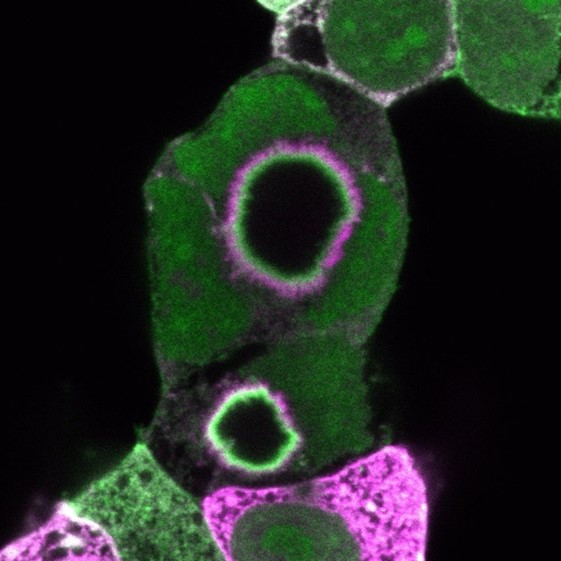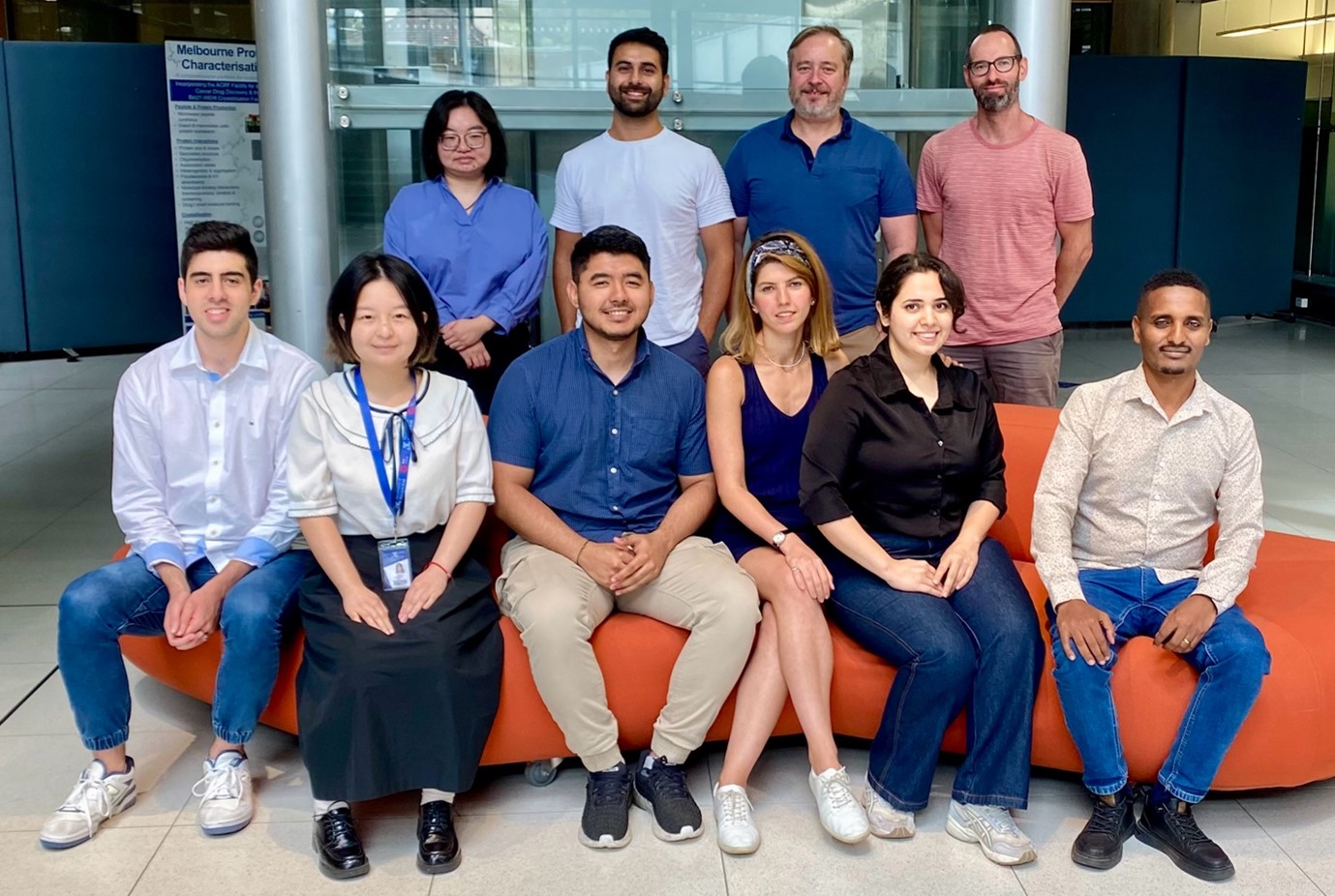Danny Hatters laboratory
-
Head of Laboratory

Professor Danny Hatters+61 3 8344 2530
Research Overview
Research in the Hatters lab investigates the molecular mechanisms driving neurodegenerative diseases involving protein misfolding and aggregation. Our primary disease targets are Huntington’s and Motor Neuron Diseases. Part of our research determines why proteins become misfolded and aggregated in these diseases and how they interact with the cellular machinery to propagate dysfunction or trigger adaptive responses to stress. Other related areas of research include defining the latent efficiency of cells to manage folding of the proteome and developing proteomics approaches to deeply examine the structural and functional changes of proteins in cells as a basis to detect irregularities in molecular functions during disease.

The image above shows aggregates of Huntingtin protein in human cells. The green stain shows soluble protein and the surface of a large inclusion body aggregate. Purple shows proteins in close proximity to the Huntingtin protein using the method of APEX proximity labelling.
Our approach is to apply multidisciplinary methods, including proteomics, transcriptomics, computational modelling, cell biology and imaging, and protein biochemistry, to understand disease mechanisms.
Staff
Dr Christian Makhoul, Post doctoral fellow
Dr Michal Ugarenko, Research Assistant
Mr Anthony Basilone, PhD Student
Ms Hanieh Beyrampour, PhD Student
Mr Kevin Castillo, PhD Student
Mr Alemu Chekol, PhD Student
Ms Samin Ghasem Zadeh, PhD Student
Ms Helen Lyu, PhD Student
Ms Mengkun Guo, Masters Student

Collaborators
Professor Rohit Pappu, Washington University in St Louis
Professor Brad Turner, Florey Institute of Neuroscience
Dr Debnath Ghosal, University of Melbourne
Associate Professor Luc Furic, Peter MacCallum Cancer Centre
Professor Gavin Reid, University of Melbourne
Associate Professor Melissa Call, Walter and Eliza Hall Institute
Funding
ARC Discovery Grant: "Painting" the 3D proteome: folding, conformation and interactions
FightMND: "Trouble at the ribosome in C9ORF72-driven amyotrophic lateral sclerosis."
Research Publications
Click here for the results of a PubMed search of Danny's publications.
Click here for the results of a Google Scholar analysis of Danny's publications.
- Kriachkov V, Ormsby AR, Kusnadi EP, McWilliam HEG, Mintern JD, Amarasinghe SL, Ritchie ME, Furic L, Hatters DM. Arginine-rich C9ORF72 ALS proteins stall ribosomes in a manner distinct from a canonical ribosome-associated quality control substrate. J Biol Chem. 2023 Jan;299(1):102774. doi: 10.1016/j.jbc.2022.102774.
- Cox D, Ormsby AR, Reid GE, Hatters DM. Protein painting reveals pervasive remodeling of conserved proteostasis machinery in response to pharmacological stimuli. NPJ Syst Biol Appl. 2022 Nov 28;8(1):46. doi: 10.1038/s41540-022-00256-3.
- Farzana F, McConville MJ, Renoir T, Li S, Nie S, Tran H, Hannan AJ, Hatters DM, Boughton BA. Longitudinal spatial mapping of lipid metabolites reveals pre- symptomatic changes in the hippocampi of Huntington's disease transgenic mice. Neurobiol Dis. 2023 Jan;176:105933. doi: 10.1016/j.nbd.2022.105933.
- Ruff KM, Choi YH, Cox D, Ormsby AR, Myung Y, Ascher DB, Radford SE, Pappu RV, Hatters DM. Sequence grammar underlying the unfolding and phase separation ofglobular proteins. Mol Cell. 2022 Sep 1;82(17):3193-3208.e8. doi: 10.1016/j.molcel.2022.06.024.
- Raeburn CB, Ormsby AR, Cox D, Gerak CA, Makhoul C, Moily NS, Ebbinghaus S, Dickson A, McColl G, Hatters DM. A biosensor of protein foldedness identifies increased "holdase" activity of chaperones in the nucleus following increased cytosolic protein aggregation. J Biol Chem. 2022 Aug;298(8):102158. doi: 10.1016/j.jbc.2022.102158.
- Cox D, Ang CS, Nillegoda NB, Reid GE, Hatters DM. Hidden information on protein function in censuses of proteome foldedness. Nat Commun. 2022 Apr 14;13(1):1992. doi: 10.1038/s41467-022-29661-2.
Research Projects
Faculty Research Themes
School Research Themes
Biomedical Neuroscience, Molecular Mechanisms of Disease, Cellular Imaging & Structural Biology, Systems Biology
Key Contact
For further information about this research, please contact Head of Laboratory Professor Danny Hatters
Department / Centre
Unit / Centre
MDHS Research library
Explore by researcher, school, project or topic.